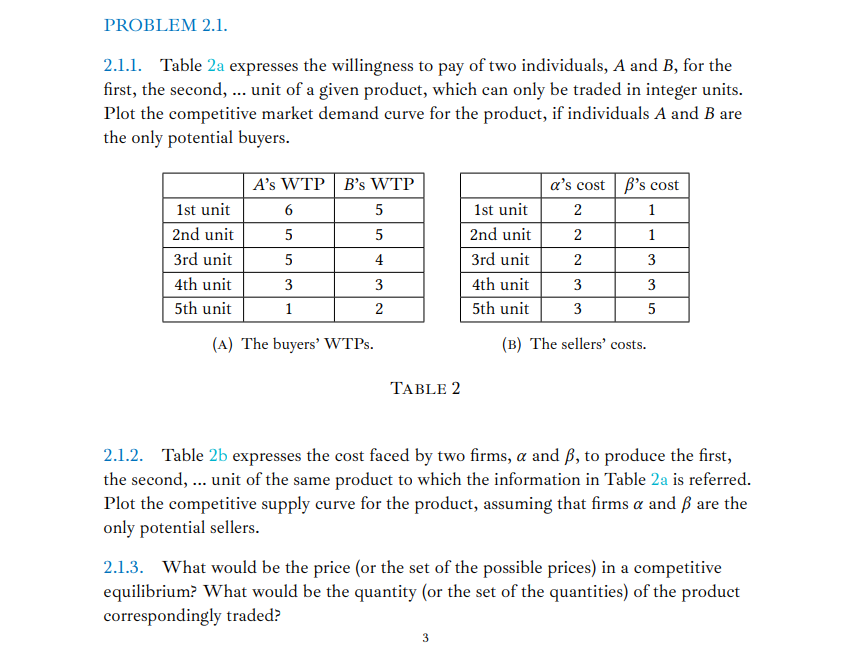Answered step by step
Verified Expert Solution
Question
1 Approved Answer
Somone who can help with this? Microeconmics, advanced 2.1.1. Table 2a expresses the willingness to pay of two individuals, A and B, for the first,
Somone who can help with this? Microeconmics, advanced 

2.1.1. Table 2a expresses the willingness to pay of two individuals, A and B, for the first, the second, ... unit of a given product, which can only be traded in integer units. Plot the competitive market demand curve for the product, if individuals A and B are the only potential buyers. (A) The buyers' WTPs. (B) The sellers' costs. TABLE 2 2.1.2. Table 2b expresses the cost faced by two firms, and , to produce the first, the second, ... unit of the same product to which the information in Table 2a is referred. Plot the competitive supply curve for the product, assuming that firms and are the only potential sellers. 2.1.3. What would be the price (or the set of the possible prices) in a competitive equilibrium? What would be the quantity (or the set of the quantities) of the product correspondingly traded? 2.1.4. Suppose that individuals A and B decide to create a monopsony. They can thus choose the (quantity, price)-pair on the market competitive supply curve to maximise their joint surplus, namely the (total) consumer surplus. What would be the price, the quantity traded and the maximised consumer surplus, in the new equilibrium? What would be the social surplus loss, if we take the competitive case as the benchmark? 2.1.1. Table 2a expresses the willingness to pay of two individuals, A and B, for the first, the second, ... unit of a given product, which can only be traded in integer units. Plot the competitive market demand curve for the product, if individuals A and B are the only potential buyers. (A) The buyers' WTPs. (B) The sellers' costs. TABLE 2 2.1.2. Table 2b expresses the cost faced by two firms, and , to produce the first, the second, ... unit of the same product to which the information in Table 2a is referred. Plot the competitive supply curve for the product, assuming that firms and are the only potential sellers. 2.1.3. What would be the price (or the set of the possible prices) in a competitive equilibrium? What would be the quantity (or the set of the quantities) of the product correspondingly traded? 2.1.4. Suppose that individuals A and B decide to create a monopsony. They can thus choose the (quantity, price)-pair on the market competitive supply curve to maximise their joint surplus, namely the (total) consumer surplus. What would be the price, the quantity traded and the maximised consumer surplus, in the new equilibrium? What would be the social surplus loss, if we take the competitive case as the benchmark
Step by Step Solution
There are 3 Steps involved in it
Step: 1

Get Instant Access to Expert-Tailored Solutions
See step-by-step solutions with expert insights and AI powered tools for academic success
Step: 2

Step: 3

Ace Your Homework with AI
Get the answers you need in no time with our AI-driven, step-by-step assistance
Get Started


